Abstract
In 2015, the UN adopted the Sustainable Development Goals (SDGs), addressing social, environmental, and economic targets. Global partnerships, transnational, and interdisciplinary research are essential for achieving progress towards the SDGs. This study analyzes 4593 research articles at the meta-level, explicitly referring to the SDGs. This a comparably small amount of research items directly addressing the goals. However, comparisons with existing approaches using different queries are possible. Research that links to the SDGs through its title, keywords, or abstract facilitates knowledge sharing on the goals as it is easier to identify relevant work. Using scientometric means, we assessed the corresponding sources, research areas, affiliated countries, thematic foci, and the availability of funding acknowledgments. The results are useful for identifying research gaps and potential collaboration possibilities. The outcomes suggest that most research referring to the SDGs comes from the research areas Life Sciences & Biomedicine and Social Sciences. The most predominant SDG among the analyzed research articles is SDG 3 (“good health and well-being”). A relatively high share of open access articles contributes to the idea of knowledge sharing for the SDGs. Nearly 37% of all articles count as international publications, i.e., as being co-authored by authors from affiliations of multiple countries.
1. Introduction
In 2015, the United Nations adopted 17 Sustainable Development Goals (SDGs) within the Agenda 2030, thus making an attempt towards ending poverty, protecting the planet and ensuring prosperity for all [1]. With these goals the United Nations aim at promoting sustainable development regarding all its manifestations, i.e., environmental, economic and social dimensions (Table 1). The most common definition of sustainable development describes it as a “development that meets the needs of the present without compromising the ability of future generations to meet their own needs” ([2], p. 37). Rather than focusing on development in developing countries, the Agenda 2030 demands action of all countries. Each goal is further substantiated in concrete targets and corresponding measurable indicators, summing up to 169 targets and more than 200 indicators which can be modified among different countries, regions or municipalities.

Table 1.
UN Sustainable Development Goals [1].
SDG 17, “Partnerships for the goals” can be regarded as a meta-goal for implementing the SDGs. Global partnerships as well as international and transnational research are essential for contributing to a sustainable development [3,4]. Several initiatives support collaboration on sustainable development in general and the SDGs in particular. For example, the Partnerships for SDGs online platform (https://sustainabledevelopment.un.org/partnerships/) provides a registry for sharing knowledge and expertise for the SDGs among different stakeholders. Besides international cooperation, the SDGs cannot be achieved without multi- and interdisciplinary research due to its complexity. “The success of the SDGs is directly related to the strengthened collaboration of its actors. In this sense, the scientific community helps in the translation of the global goals into practical national and local levels agendas” ([4], p. 843). The Aurora Universities Network coordinates an initiative to map research output to the SDGs. Within a survey, researchers were requested to assign their research to the SDGs (https://aurora-network.global/project/sdg-analysis-bibliometrics-relevance/), which helps in identifying collaborators and relevant research output.
Research which supports the SDGs can assume different forms. In particular, two forms can be distinguished:
- Research that supports the progress towards particular targets of the SDGs without necessarily referring to the SDGs (e.g., research on poverty alleviation or climate change without reference to its contributions on the SDGs)
- Research that directly refers to the SDGs (e.g., meta-research that is concerned with the overall political agenda behind the SDGs, or, studies that work towards particular targets but still mention the overall contribution to the SDGs)
This article seeks to assess current research on the SDGs that directly refers to the goals. By doing so, we contribute to the assessment of the current status of research on the SDGs and demonstrate research gaps as well as potential for further collaboration which is essential for achieving progress towards the goals. “If knowledge production occurs along existing disciplinary lines, we risk losing the relationships that are so important to understanding the legitimacy and potential of the SDGs” ([5], p. 5). Making use of existing knowledge and research is an essential prerequisite for producing further knowledge. Mapping existing research on the SDGs can be a first step to achieve this goal considering sustainable development. Research that directly refers to the SDGs facilitates knowledge sharing on the goals as it is easier to identify relevant work. However, it should be noted that this study only analyzes a comparably small amount of articles at the meta-level, as we focus on articles explicitly mentioning the SDGs. With other queries, further research items relevant to the goals are available, but here the focus is on articles directly addressing them. Thereby comparisons can be made to existing approaches.
Some argue that a reclassification of academic fields is necessary if the SDGs are taken seriously, whereby academics are required to operate across disciplines [6]. Similarly, Education for Sustainable Development (ESD) requires interdisciplinary approaches [7]. Cooperation among different countries is another crucial aspect of collaboration that is necessary for achieving progress towards the SDGs, especially when considering the global scope of the goals. For example, North-South collaboration can be beneficial for knowledge sharing; in particular, countries with limited funding possibilities for research can benefit from potential financial resources resulting from collaborations [8].
With this article, we aim at presenting an overview on research directly addressing the SDGs and thus facilitating knowledge sharing among countries and academic fields. The following section will provide relevant literature for this article and the corresponding analysis. After that, the methodological approach is described, followed by a presentation of the results. Finally, the results will be discussed in the last section.
2. Literature Review
There are some qualitative as well as quantitative studies examining research regarding sustainable development. In order to assess research trends with regard to the SDGs, Salvia et al. [4] conducted a survey with 266 experts from different countries. The survey aimed at identifying those SDGs that are addressed by the experts. In North America, the most mentioned goals were—in descending order - SDG 11, 13, 15 and 4, whereas European experts concentrated on SDGs 4, 11, 12 and 13. In contrast, SDGs 13, 4, 11 and 15 were predominant in Asia.
Another approach was used by Körfgen et al. [9]. They also directly addressed the 17 SDGs, but created a complex search string for each of the SDGs using an iterative approach in order to quantitatively analyze research with regard to each SDG. These search strings were then used to identify relevant publications from 13 Austrian universities in order to assess the focus areas of SDGs related research in Austria. By far the strongest representation among the SDGs is SDG 4 on quality education. Overall, social and economic goals seem to be better represented than environmental goals due to this study.
There are some further quantitative bibliometric studies aiming at mapping research regarding sustainable development in general or the SDGs in particular, especially with regard to the represented countries publishing research on sustainable development. A general bibliometric study on international research regarding sustainable development was performed by Hassan, Haddawy, and Zhu [10]. They used a collection of keyword terms addressing sustainable development and its subareas and performed their query on the Scopus database. Their findings show that overall research on sustainable development is lead by the United States in terms of publication numbers and citations. With regard to different subtopics, other countries could be identified as predominant, e.g., climate change (UK), renewable energy (China) or forestry (Finland).
In contrast to the approach of collecting several keyword terms on the subareas of sustainable development, Zhu and Hua [11] used the phrase “sustainable development” as a search term in the Web of Science database and analyzed research from 1987 to 2015 by bibliometric means. They assessed the references, keywords, countries and categories of nearly 60,000 publications. In their study, most journals of the corresponding articles were located in the US, UK or the Netherlands. Again, publications from the US were the most predominant in terms of citations, whereas most publications in the analyzed set were from China.
Similarly, Olawumi and Chan [12] analyzed more than 2000 articles from 1991–2016 on sustainable development embedded in Web of Science Core Collection. Most journals in their study originated from the US, China, UK and Canada. The main research topics that could be identified were sustainable urban development, sustainable indicators and impact, water management, environmental assessment, strategy, public policy and monitoring, cost-benefit analysis, stakeholders’ participation, campus sustainability at universities and human ecology.
In general, most quantitative bibliometric studies concentrate on analysing documents from one database such as Scopus or Web of Science. However, the coverage between different databases can differ tremendously [13,14]. When using the Web of Science Core Collection, further attention should be drawn to the corresponding institutional subscriptions used for the analysis, because it leads to differences in the resulting hits [15]. Furthermore, Scopus and Web of Science show an over-representation of documents from English language journals [14,16,17] and seem to introduce biases by favouring research in the Natural Sciences, Engineering and Biomedical Research [14]. Still, these databases remain the main multidisciplinary sources for bibliometric analyses.
The above studies analyzed thematic foci of different countries. When analyzing publication output, international collaboration between the countries is of particular interest. With SDG 17, the importance of partnerships for achieving progress towards the SDGs is stressed. In general, international collaboration in science is growing [18,19,20]. Some studies analyzed the relation between international collaboration and research impact, whereby a small positive effect of international co-authorship on citations could be detected [21]. International collaboration further seems to be associated with international funding [22].
Considering these findings, we analyzed more than 4000 publications from Web of Science Core Collection and Scopus published between 2015 and 2019, assessing corresponding research areas and sources, countries and international collaboration, thematic foci as well as funding acknowledgements. The following section presents the methodological approach.
3. Materials and Methods
In order to analyze research directly addressing the SDGs, two multidisciplinary databases were used: Scopus and the Web of Science (WoS) Core Collection. As described above, there are disparities in the amount and type of coverage between these databases, hence we decided to include both databases in our analysis in order to draw a more complete picture. The queries were performed on 6 November 2019 using the search string “Sustainable Development Goals” as a phrase in the fields TOPIC (WoS) respectively TITLE-ABS-KEY (Scopus). The search was narrowed to documents with publication years between 2015–2019 and the document type ‘article’. This time span was used because of the adoption year of the SDGs in 2015. Regarding the Web of Science Core Collection, it is important to note which editions are included, due to institutional differences in subscriptions [15]. The set used in this analysis consists of the following collections and coverage time spans.
- SCI-EXPANDED: Science Citation Index Expanded (1945-present)
- SSCI: Social Sciences Citation Index (1956-present)
- A&HCI: Arts & Humanities Citation Index (1975-present)
- ESCI: Emerging Sources Citation Index (2015-present)
The queries resulted in 3943 hits in Scopus as well as 3241 hits in the WoS Core Collection. In each database, all available metadata, abstract, keyword, funding and authors’ affiliation information of these documents were downloaded as a CSV-file and processed with the Python programming language. After cleaning the data, duplicates in the databases were identified and mapped. For some fields, further data had to be edited. For example, synonyms were merged (e.g., ‘USA’, ‘United States’ and ‘US’ in the affiliation field) and a thesaurus file was created for the keywords (e.g., sustainable development goal; un sustainable development goals → sustainable development goals). A second thesaurus file was created for mapping the keywords to the SDGs (e.g., health policy → good health and well-being (SDG 3); poverty alleviation → no poverty (SDG 1)). For this purpose, the United Nations’ descriptions, including the particular targets and indicators of each goal were used and mapped to the keywords manually.
Each database has its own classification system regarding the corresponding research areas of the articles. For mapping the research areas of the analyzed documents, this article relies on the suggestions of [16]. Five main categories are distinguished, which are based on the classification of the Web of Science Core Collection [23]. These categories are:
- Arts & Humanities
- Life Sciences and Biomedicine
- Physical Sciences
- Social Sciences
- Technology
For articles from Scopus, a mapping to these five categories was conducted according to [16], whereas the category “Multidisciplinary” remained unaffected. Each article can be dedicated to several research areas and the assignment is hence not unique.
For analyzing international collaboration, we evaluated the affiliation fields in our dataset. Following [18], a research piece can be considered as international, when at least two different countries are represented among the authors’ affiliations, while papers with only one affiliation country can be considered as domestic. For assessing existing funding, we used a dichotomous approach, simply marking those articles with existing funding information in Scopus or WoS.
The evaluation of the documents was then performed with Python and its modules pandas and matplotlib. In some cases, some information was missing for the articles (e.g., no keywords or abstract), so that some analyzes only considered those documents where the corresponding information was given. Network maps were created with VosViewer 1.16.11, which is a freely available tool for visualizing networks from bibliometric data, such as authors, journals, co-citations or keywords [24].
4. Results
After mapping duplicates within the hits, 3934 documents remained for the analysis from the Scopus database, whereas 3237 documents could be analyzed from WoS. From these, 2578 could be identified in both databases (Figure 1). As a result, 1356 documents were solely dedicated to Scopus, while 659 articles were only found in WoS. In total, 4593 documents could be used for the overall analysis.
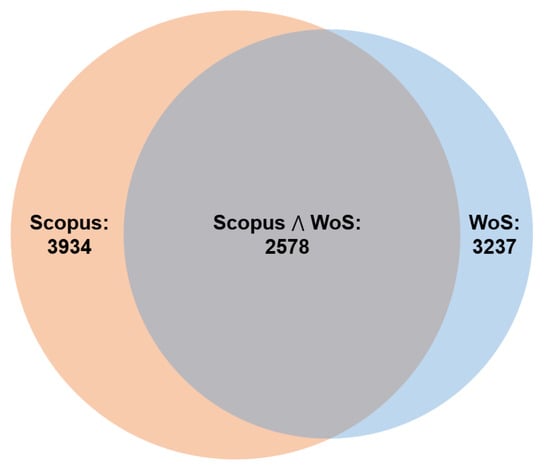
Figure 1.
Number of articles from 2015–2019 with TOPIC=TITLE-ABS-KEY=“Sustainable Development Goals” in the databases Scopus and WoS Core Collection.
4.1. Sources and Research Areas
In general, research directly addressing the SDGs in the abstract, title or keywords is constantly growing since 2015. This is also true with regard to the different research areas (Figure 2). However, differences can be observed in the absolute numbers of research items per discipline. Overall, the most prevalent research area is Life Sciences & Biomedicine (2261 articles), followed by Social Sciences (1960 articles) and Technology (850 articles). In comparison, the categories Physical Sciences as well as Arts & Humanities are underrepresented with 121 and 110 articles respectively. Furthermore, 49 articles were classified as Multidisciplinary. Note again, that one article can be dedicated to more than one research are, which is why the sum of the articles in each research area exceeds the number of all documents ().
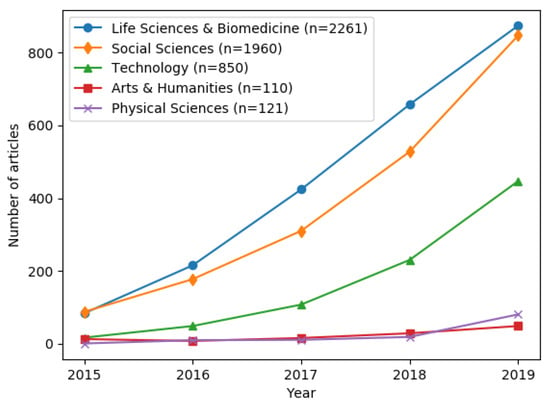
Figure 2.
Number of articles per research area and year.
From the 4593 analyzed documents, 1330 articles (29%) acknowledge some kind of funding for the research, whereby variations could be detected across the research areas: Life Sciences & Biomedicine report about funding in 38.9% of the articles, Social Sciences in 30.4%, Technology in 34.3%, Arts & Humanities in 19.1% and Physical Sciences in 53.7% of the research items.
The 4593 analyzed articles were published in 1667 different sources, whereby Sustainability is by far the most occurring journal with 273 published documents. Noticeably, several open access journals such as Sustainability, PLOS ONE or BMJ Global Health are among the sources. In total, nearly 45% of all articles are published under an open access licence.
Figure 3 shows the top 15 sources according to the number of articles in descending order. With 863 publications, these 15 journals make up only 0.9% of all sources but account for 18.8% of all articles in our initial set. The degree of inequality becomes apparent when looking at the corresponding Lorenz curve and Gini coefficient () for the sources of the analyzed articles (Figure 4). In the Lorenz curve, the cumulative proportion of journals is plotted against the cumulative proportion of the total number of articles and thus the degree of inequality is visualized [25]. The more the blue curve deviates from the perfect equality line, the less journals do contribute equally to the number of articles published. The Gini coefficient (ranging from 0 = perfect equality to 1 = complete inequality) summarizes the degree of concentration in one number.
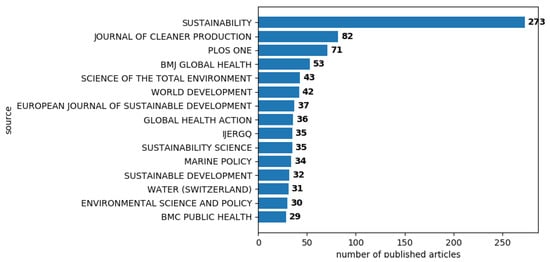
Figure 3.
Top 15 sources that published articles addressing the SDGs.
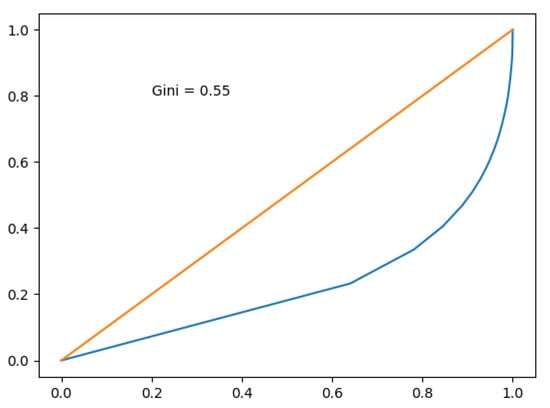
Figure 4.
Lorenz curve with Gini coefficient for the sources of articles.
4.2. Affiliation Countries and International Collaborations
Taking a look at the countries that belong to the authors’ affiliations, a total of 184 countries are represented in our study. From the 4593 articles, 1005 were published with at least one author affiliated with an institution in the United States. This is followed by 822 articles with involvement from the United Kingdom. The 15 most occurring countries are depicted in Figure 5. Aggregating the number of publications per continent, however, European countries are involved in 2071 publications, North America in 1229 and Asia in 1138 publications. Nearly half (2270) of all publications are domestic articles (only one country among the authors’ affiliations), whereas for 634 documents no affiliation information was given. The remaining 1689 publications are considered as international publications (at least two countries among the authors’ affiliations). Most of these (985) were published by authors from two countries, followed by 341 documents from three countries and 363 articles from four or more countries. Figure 6 shows the amount of domestic and international articles by research area. Documents without affiliation information are excluded. With 69% the highest relative share of domestic articles was detected in Arts & Humanities, while the lowest share of domestic articles comes from Physical Sciences (51%). Because of the different amount of publications per research areas, these variations are not significant.
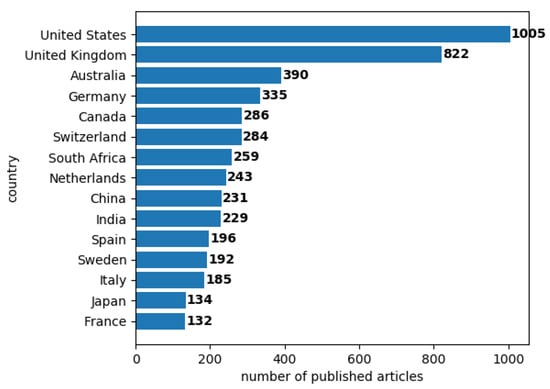
Figure 5.
Top 15 countries that are involved in articles addressing the SDGs.
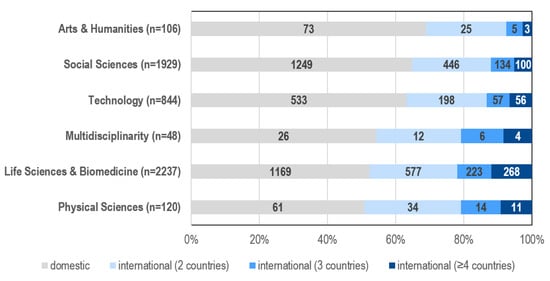
Figure 6.
Share of domestic and international publications by research area.
International articles tend to have more funding available than domestic articles. From the 2269 domestic articles, 610 (27%) acknowledge some funding, whereas from the 1690 international articles, 714 (42%) report about funding. Calculating Spearman’s between the number of countries involved in an article and the relative share of funded articles, a significant positive correlation can be detected (, ), indicating that the more countries are involved in an article, the more it is likely to get funding.
Concentrating on the countries that are involved in at least 50 publications (35 countries) and calculating the share of international publications per country for these, the highest share of international articles is published by Belgium (93%), Kenya (87%), France (86%), Denmark and Switzerland (both 85%) as well as Bangladesh (83%). In contrast, low shares of international publications were calculated for the Russian Federation (42%), India (46%) and Nigeria (47%).
Figure 7 visualizes four clusters based on the co-occurrence of countries according to the authors’ affiliations. Included are all countries that are involved in at least 50 publications. This condition is true for 35 countries. The size of a country’s frame reflects the number of publications in our set that are associated to the country. The first cluster consists of eleven European countries and in addition Ethiopia, Ghana, Iran and the Russian Federation. The second cluster consists of nine Asian countries, Australia and New Zealand. Cluster 3 and 4 entail the United States and the United Kingdom, respectively, the two most occurring countries. Whereas the United Kingdom can be linked especially to the African countries Kenya, Nigeria and South Africa, strong links were found with the United States and Brazil, Canada, India, Mexico as well as Switzerland.
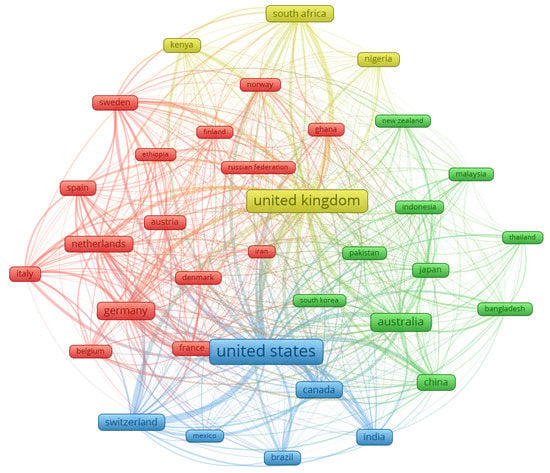
Figure 7.
Clusters of 35 countries with at least 50 associated publications based on co-occurrence of authors’ affiliation countries, map created with VosViewer 1.16.11.
4.3. Thematic Foci
Depending on our query, documents in this study contain the phrase “Sustainable Development Goals” in its title, abstract or the assigned keywords. From the documents in the initial set, 1169 articles contained the phrase among their keywords, 3471 in the abstract and 738 in its title. Analysing the corresponding keywords of all documents in more detail, we can discover five main keyword clusters (Figure 8). Our search phrase Sustainable Development Goals is naturally at the center of the keyword map and forms a cluster with the keywords Agenda 2030 and United Nations which together describe the agenda in general. Furthermore, these keywords are associated with the thematic foci human rights, inequalities, migration, and poverty.
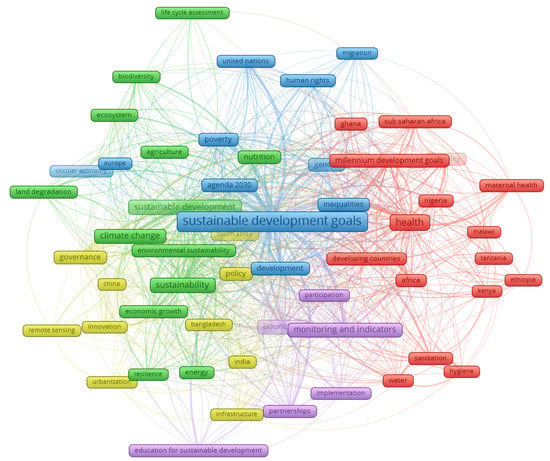
Figure 8.
Clusters of author keywords based on co-occurrence of the keywords with at least 20 occurrences (71 keywords), map created with VosViewer 1.16.11.
The biggest cluster around the general keyword sustainable development shows a focus on health-related topics, e.g., hygiene, maternal health, and mortality, thus representing SDG 3. Further keywords in this cluster are linked to water and sanitation (SDG 6) as well as keywords showing a focus on African countries according to keyword co-occurrences. These keywords are further linked to the Millennium Development Goals - the predecessor of the SDGs.
Another cluster around the general keyword sustainable development shows a focus on environmental sustainability, represented by keywords such as energy (SDG 7), climate change (SDG 13), land degradation (SDG 15) and biodiversity (SDGs 14 and 15), but also economic growth (SDG 8), as well as agriculture and nutrition (SDG 2).
The other two clusters have their focus on governance, policy, innovation and infrastructure in relation to urbanization and the countries Bangladesh, South Africa and China, respective the keywords education (SDG 4), Education for Sustainable Development, as well as implementation, monitoring and indicators, partnerships (SDG 17) and participation.
Considering the mapped SDGs on the keywords for each country, thematic foci for the countries in terms of keyword occurrences can be discovered. Research from the 15 countries with the highest research output directly addressing the SDGs in particular concentrates on SDG 3, good health and well-being which has already been detected as a main keyword in Figure 8. Except for Italy, keywords reflecting this SDG are among the two most widely addressed SDGs (Table 2).

Table 2.
Focal SDGs per Country.
Aggregating the countries to the corresponding continents (and Oceania), again SDG 3 is the most occurring SDG for all continents (Table 3). Furthermore, SDG 6 is among the top 5 SDGs for all continents. In contrast, SDG 10 is mainly addressed in all continents except for South America. SDG 4 is a focus in Europe and South America, and partly Africa. SDGs 1, 2, 5, 7, 8, 9, 11, 12, 14, 15 are not among the top 5 occurring themes in all continents according to the used keywords.

Table 3.
Focal SDGs per Continent.
5. Discussion
With the Sustainable Development Goals, the United Nations adopted an ambitious agenda aiming at ending poverty, protecting the planet and ensuring prosperity for all. Partnerships for the goals (SDG 17) as well as international and interdisciplinary research are regarded as crucial for achieving progress towards the SDGs. In this paper, we assessed the current status of research on the 17 goals by analyzing research articles directly addressing the SDGs. For this purpose we used scientometric means, more precisely, we downloaded metadata and content-related information for more than 4500 publications from the WoS Core Collection and Scopus published between 2015 and 2019. The resulting dataset was analyzed with regard to the associated sources and research areas, affiliation countries and international collaboration as well as thematic foci.
The comparably small amount of research articles directly addressing the SDGs available in the databases WoS and Scopus shows that many authors do not yet link their research to the goals. For facilitating knowledge sharing on the SDGs, it would be useful to raise awareness by directly referring to them. Of course, it is not necessary to mention the SDGs for achieving progress towards them in general. Still, revealing research articles connected to the goals and making these more visible and more comfortable to find would contribute to establishing collaboration and partnerships, thus directly strengthen progress towards SDG 17. This gap becomes especially evident with the sophisticated search strings other researchers had to apply for mapping SDG related research, e.g., as presented in [9].
In our study, the most prevalent source for articles addressing the SDGs is the journal Sustainability located in Switzerland. According to [12], most journals publishing research on sustainable development are located in the US, China, UK and Canada when referring to the WoS Core Collection. In general, several studies have shown that publications from English-speaking countries as well as English language journals are over-represented in databases like Scopus or Web of Science [16]. This is also true for research on the SDGs, as confirmed by [10]. Similarly, research from English-speaking countries is predominant in our study. Nearly half of the publications in our dataset are domestic articles, i.e., articles authored by persons from one country only. Thereby, the share of international articles varies among research area and country. A positive correlation between the number of involved countries and the availability of funding acknowledgements could be calculated, which supports previous research by [22].
In contrast to a general underestimation of the Social Sciences in the databases Scopus and WoS found in previous studies [14], according to our findings this research area is strong regarding research addressing the SDGs (1960 articles). However, the most prevalent research area in our dataset is Life Sciences & Biomedicine (2261 articles), which explains the strong thematic focus on health-related topics detected through the keywords. This research area further seems to benefit most from funding possibilities according to the funding acknowledgements gathered from WoS and Scopus.
In contrast to the survey by [4], we identified other predominant SDGs in our dataset. In Asia, Europe and North America, the experts of the study by [4] commonly referred to SDG 4 (quality education), 11 (sustainable cities and communities) and 13 (climate action), but also SDG 15 (life on land - Asia and North America) and SDG 12 (responsible consumption and production - Europe). In contrast, research directly referring to the SDGs in particular focuses on SDG 3 (good health and well-being) in all continents. Further predominant SDGs in research of all continents are SDG 6 (clean water and sanitation) and SDG 10 (reduced inequalities). The prevalence of SDG 13 as well as SDG 4 in Europe conforms with the study of [4]. A strong focus of Austrian universities on SDG 4 was also detected by [9]. Compared to the study of [12] some thematic overlaps could be detected. For example, monitoring sustainable development and according indicators were deemed relevant in both studies. In contrast, our analysis revealed a strong focus on health-related topics, which is not a priority according to [12].
This study has some limitations. While most bibliometric studies regarding a specific topic focus on documents from one database, we consulted two popular databases to get a more complete picture. Still, Scopus and Web of Science do not cover every research item and especially with regard to the WoS Core Collection, the coverage depends on institutional subscriptions [15]. The coverage between the databases differs notably, but both show an over-representation of documents from English language journals [14,16,17]. As we performed our query in November 2019, the records for 2019 are not complete. Using the same query in April 2020, 350 and 450 further articles are available in the databases Scopus respectively WoS, which were not considered in our bibliometric analysis. In addition, analyzing funding acknowledgement has its limitations. While funding acknowledgement is fully covered for documents published since 2015 in the WoS SSCI, the WoS A&HCI subset is not covered [26]. Furthermore, there are differences regarding the availability of funding information between Scopus and WoS [27]. Again, with the use of these two databases we reduced the limitations. The query strategy used in this study is quite simple. Searching with the phrase “Sustainable Development Goals” does not include those documents dealing with subtopics of sustainable development that do not directly refer to the SDGs, but still support progress towards them. We used the approach to reveal those articles that are already including this phrase in their title, abstract, and keywords, thus facilitating to identify SDG-related research. We did not include the abbreviation “SDG” in the query, as it stands for several further scientific concepts, such as “spatial distribution of gradients”.
6. Conclusions
Despite these limitations, this study reveals some interesting insights into current research addressing the SDGs. The existing thematic foci reveal current research gaps. While SDG 3 is already well represented in research addressing the SDGs in articles by authors from all countries, other SDGs, such as SDG 1 (no poverty), 5 (gender equality), 11 (sustainable cities and communities) or 16 (peace, justice and strong institutions) are barely represented in our dataset. This does not mean, that there is no research supporting these SDGs, but that existing research in these areas does not necessarily refer to the goals by addressing the SDGs in its title, abstract or keywords. If all research supporting the goals was directly linked to the SDGs, knowledge sharing could be facilitated and progress towards the goals would be supported.
In addition, even though transnational cooperation is apparent with nearly 37% of all articles being co-authored by authors from affiliations of multiple countries, collaboration can still be expanded in future research on the SDGs. The relatively high share of articles being published open access and the presence of pure open access journals among the main sources for articles addressing the SDGs further supports the idea of knowledge and information sharing which is also among the targets of the SDGs (Target 16.10: “Ensure public access to information and protect fundamental freedoms, in accordance with national legislation and international agreements” [28]). There are also efforts on identifying the role of open access for the SDGs, e.g., as formulated by the International Federation of Library Associations and Institutions (https://blogs.ifla.org/lpa/2018/10/24/how-open-access-can-help-achieve-sustainable-development-goals-sdgs/).
In the future, research could focus on this special role of open access for the SDGs, but also on other solutions for further facilitating knowledge sharing on the SDGs. The comparable low availability of articles directly addressing the SDGs, respective the complex queries used by other authors, reveal that more research is necessary to map SDG-related research adequately, and to facilitate knowledge sharing thereon. Additionally, practical solutions to broaden the network and foster collaboration regarding the goals are crucial.
In addition to the mere availability of funding acknowledgments, it would be interesting to analyze the types of funding bodies, e.g., governmental institutions, commercial enterprises, or non-profit foundations. That would require a mostly qualitative analysis of the funding texts available in the databases. This bibliometric overview can serve as a starting point for identifying current countries, sources and thematic foci in existing research articles addressing the SDGs.
Funding
This research received no external funding.
Acknowledgments
The author acknowledges the support for publishing open access by the Heinrich Heine University Düsseldorf.
Conflicts of Interest
The author declares no conflict of interest.
Abbreviations
The following abbreviations are used in this manuscript:
| SDGs | Sustainable Development Goals |
| ESD | Education for Sustainable Development |
| WoS | Web of Science |
| SSCI | Social Sciences Citation Index |
| A&HCI | Arts & Humanities Citation Index |
References
- United Nations. Sustainable Development Goals. Available online: http://www.un.org/sustainabledevelopment/sustainable-development-goals/ (accessed on 5 September 2019).
- WCED. Report on the World Commission on Environment and Development. Our Common Future; United Nations: New York, NY, USA, 1987; pp. 1–247. [Google Scholar]
- Leal Filho, W.; Azeiteiro, U.; Alves, F.; Pace, P.; Mifsud, M.; Brandli, L.; Caeiro, S.; Disterheft, A. Reinvigorating the sustainable development research agenda: The role of the sustainable development goals (SDG). Int. J. Sustain. Dev. World Ecol. 2018, 25, 131–142. [Google Scholar] [CrossRef]
- Salvia, A.L.; Leal Filho, W.; Brandli, L.L.; Griebeler, J.S. Assessing research trends related to Sustainable Development Goals: Local and global issues. J. Clean. Prod. 2019, 208, 841–849. [Google Scholar] [CrossRef]
- Halvorsen, T.; Ibsen, H.; Evans, H.C.; Penderis, S. Introduction. In Knowledge for Jjustice. Critical Perspectives from Southern African-Nordic Research Partnerships; Halvorsen, T., Ibsen, H., Evans, H.C., Penderis, S., Eds.; African Minds, SANORD: Cape Town, South Africa, 2017; pp. 1–9. [Google Scholar]
- Halvorsen, T. The Sustainable Development Goals, knowledge production and the global struggle over values. In Knowledge for Justice. Critical Perspectives from Southern African-Nordic Research Partnerships; Halvorsen, T., Ibsen, H., Evans, H.C., Penderis, S., Eds.; African Minds, SANORD: Cape Town, South Africa, 2017; pp. 13–36. [Google Scholar]
- Annan-Diab, F.; Molinari, C. Interdisciplinarity: Practical approach to advancing education for sustainability and for the Sustainable Development Goals. Int. J. Manag. Educ. 2017, 15, 73–83. [Google Scholar] [CrossRef]
- Mago, S. North–South research collaboration and the Sustainable Development Goals: Challenges and opportunities for academics. In Knowledge for Justice. Critical Perspectives from Southern African-Nordic Research Partnerships; Halvorsen, T., Ibsen, H., Evans, H.C., Penderis, S., Eds.; African Minds, SANORD: Cape Town, South Africa, 2017; pp. 163–174. [Google Scholar]
- Körfgen, A.; Förster, K.; Glatz, I.; Maier, S.; Becsi, B.; Meyer, A.; Kromp-Kolb, H.; Stötter, J. It’s a Hit! Mapping Austrian research contributions to the sustainable development goals. Sustainability 2018, 10, 3295. [Google Scholar] [CrossRef]
- Hassan, S.U.; Haddawy, P.; Zhu, J. A bibliometric study of the world’s research activity in sustainable development and its sub-areas using scientific literature. Scientometrics 2014, 99, 549–579. [Google Scholar] [CrossRef]
- Zhu, J.; Hua, W. Visualizing the knowledge domain of sustainable development research between 1987 and 2015: A bibliometric analysis. Scientometrics 2017, 110, 893–914. [Google Scholar] [CrossRef]
- Olawumi, T.O.; Chan, D.W. A scientometric review of global research on sustainability and sustainable development. J. Clean. Prod. 2018, 183, 231–250. [Google Scholar] [CrossRef]
- Gavel, Y.; Iselid, L. Web of Science and Scopus: A journal title overlap study. Online Inf. Rev. 2008, 32, 8–21. [Google Scholar] [CrossRef]
- Mongeon, P.; Paul-Hus, A. The journal coverage of Web of Science and Scopus: A comparative analysis. Scientometrics 2016, 106, 213–228. [Google Scholar] [CrossRef]
- Liu, W. The data source of this study is Web of Science Core Collection? Not enough. Scientometrics 2019, 121, 1815–1824. [Google Scholar] [CrossRef]
- Vera-Baceta, M.A.; Thelwall, M.; Kousha, K. Web of Science and Scopus language coverage. Scientometrics 2019, 121, 1803–1813. [Google Scholar] [CrossRef]
- Archambault, É.; Vignola-Gagne, É.; Côté, G.; Larivière, V.; Gingras, Y. Benchmarking scientific output in the social sciences and humanities: The limits of existing databases. Scientometrics 2006, 68, 329–342. [Google Scholar] [CrossRef]
- Glänzel, W. National characteristics in international scientific co-authorship relations. Scientometrics 2001, 51, 69–115. [Google Scholar] [CrossRef]
- Wagner, C.S.; Whetsell, T.A.; Leydesdorff, L. Growth of international collaboration in science: Revisiting six specialties. Scientometrics 2017, 110, 1633–1652. [Google Scholar] [CrossRef]
- Ribeiro, L.C.; Rapini, M.S.; Silva, L.A.; Albuquerque, E.M. Growth patterns of the network of international collaboration in science. Scientometrics 2018, 114, 159–179. [Google Scholar] [CrossRef]
- Leydesdorff, L.; Bornmann, L.; Wagner, C.S. The Relative Influences of Government Funding and International Collaboration on Citation Impact. J. Assoc. Inf. Sci. Technol. 2019, 70, 198–201. [Google Scholar] [CrossRef]
- Morillo, F. Collaboration and impact of research in different disciplines with international funding (from the EU and other foreign sources). Scientometrics 2019, 120, 807–823. [Google Scholar] [CrossRef]
- Clarivate Analytics. Research Areas (Categories/Classification). Available online: https://images.webofknowledge.com/images/help/WOS/hp_research_areas_easca.html (accessed on 14 November 2019).
- Van Eck, N.J.; Waltman, L. Software survey: VOSviewer, a computer program for bibliometric mapping. Scientometrics 2010, 84, 523–538. [Google Scholar] [CrossRef]
- Bornmann, L.; Mutz, R.; Neuhaus, C.; Daniel, H.D. Citation counts for research evaluation: Standards of good practice for analyzing bibliometric data and presenting and interpreting results. Ethics Sci. Environ. Polit. 2008, 8, 93–102. [Google Scholar] [CrossRef]
- Paul-Hus, A.; Desroches, N.; Costas, R. Characterization, description, and considerations for the use of funding acknowledgement data in Web of Science. Scientometrics 2016, 108, 167–182. [Google Scholar] [CrossRef]
- Kokol, P.; Blažun Vošner, H. Discrepancies among Scopus, Web of Science, and PubMed coverage of funding information in medical. J. Med. Libr. Assoc. 2018, 106, 81–86. [Google Scholar] [CrossRef] [PubMed]
- United Nations, Department of Economic and Social Affairs, Population Division. World Urbanization Prospects: The 2018 Revision; United Nations: New York, NY, USA, 2019. [Google Scholar]
© 2020 by the author. Licensee MDPI, Basel, Switzerland. This article is an open access article distributed under the terms and conditions of the Creative Commons Attribution (CC BY) license (http://creativecommons.org/licenses/by/4.0/).